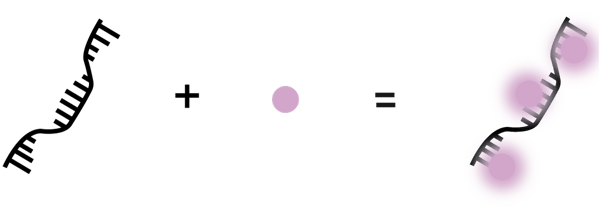Introduction
CRISPR-Cas systems are increasingly topical in the fields of genome engineering and diagnostics applications. When screening target sites for CRISPR protein binding or cleavage it is often necessary to test multiple CRISPR RNAs (crRNAs). Ordering multiple chemically synthesized crRNAs is often cost prohibitive and therefore in vitro transcription from DNA templates are used to generate the required RNA. However, downstream applications require the normalisation of crRNA concentration using accepted techniques such as a biospectrophotometer or a fluorometer and intercalating dyes. These techniques are expensive, time consuming, and not high-throughput enough to be practical.
Here we describe the use of the CLARIOstar Plus microplate reader, with the Labcyte Echo® 525 liquid handler, to robustly and inexpensively measure RNA concentration of crRNAs using the Qubit™ RNA BR Assay kit.
Assay Principle
Materials & Methods
- 384 well PS microplate (Greiner Bio-One #781096)
- 384 well PP Echo® Qualified microplate (Greiner Bio-One)
- Echo® Qualified 6-well reservoir (Labcyte)
- Agilent PlateLoc Thermal Microplate Sealer CLARIOstar Plus (BMG LABTECH)
- Qubit™ RNA BR Assay kit (ThermoFisher Scientific)
Experimental Procedure
All experimental liquids were transferred using the Echo® 525 Liquid Handler unless otherwise noted. Reactions were randomized to reduce position related effects.
Preparation of crRNAs
CRISPR RNAs were in vitro transcribed in a 96 Well Plate and purified using a CyBio FeliX (Analytik Jena) and Agencourt RNAClean XP beads (Beckman Coulter). As the final step of purification, crRNAs were eluted from the magnetic beads and transferred to a 384 well PP Echo® Qualified microplate.
Quantification of crRNAs
The Qubit™ RNA BR Assay kit was used for quantification. Reactions were scaled down to a total of 10 µl (diluted 9.95 µl of working solution with 0.05µl of Sample RNA). Standards had RNA volumes from 0.5µl to 0.025 µl with working solution to make up to 10 µl. The buffer and inter-calating dye were premixed to form the working solution and then loaded into a 6-well reservoir plate. Liquid transfers were performed using the ‘6RES_AQ_BP2’ and ‘384PP_AQ_BP’ energy settings for the working solution and RNA respectively. Working solution was added to all wells of a 384 well PS microplate followed by addition of RNA. The plate was then sealed and centrifuged for 60 seconds at 1000 rpm followed by an incubation for 5 mins in the dark before being read on the CLARIOstar Plus. Data were analysed using a custom python script. Local outliers were removed using Local Outlier Probabilities (LoOP) where the probability of a removed outlier was greater than 90% 1, 2.
Determination of Plate Reader Settings
The spectral scan function on the CLARIOstar Plus was used to determine the excitation and emission spectra of the Qubit™ RNA dye (Fig. 1). The 100 ng/µl standard (Standard 2) from the Qubit™ RNA kit was used. There was negligible background and therefore no background subtraction was needed.
Instrument settings
| Optic settings | Fluorescence intensity, bottom optic | |
| Excitation | 625-15 | |
| Dichroic | 645 | |
| Emission | 665-15 | |
| Enhanced Dynamic Range | ||
| Focal height | 3.9 mm | |
| General settings |
Number of flashes |
20
|
| Settling time |
0.1 s
|
|
| Extended IR Detector |
used
|
|
Results & Discussion
A standard curve (Fig. 3) for conversion of fluorescence to concentration was determined using serial dilutions of the RNA standards that come with the Qubit™ RNA BR Assay kit (Standard 1 and Standard 2).
 crRNAs that had been purified were then quantified and fit to the standard curve to determine their concentration.
crRNAs that had been purified were then quantified and fit to the standard curve to determine their concentration. Fluorescence values of the RNAs are used to convert fluorescence to concentration using the standard curve. The data allowed to calculate the limit of detection (LOD) of this RNA quantification method. With 1.8 ng/µl the detection limit is close to kits specification of 1 ng/µl, even though the reaction volume is reduced by 20x.
Fluorescence values of the RNAs are used to convert fluorescence to concentration using the standard curve. The data allowed to calculate the limit of detection (LOD) of this RNA quantification method. With 1.8 ng/µl the detection limit is close to kits specification of 1 ng/µl, even though the reaction volume is reduced by 20x.
The molecular mass of the RNA can then be used to get a molar concentration, which is more relevant for most biological assays (Fig. 4).
Conclusion
The Qubit™ RNA BR assay has been successfully implemented using Labcyte and BMG LABTECH technologies. The ability to translate the assay from a low-throughput methodology to a microplate reader with randomization and miniaturisation, makes the technique practical for high-throughput, robust quantification.
References
- Constantinou, V. PyNomaly: Anomaly detection using Local Outlier Probabilities (LoOP). J Open Source Softw 3, 845 (2018).
- Kriegel, H.-P., Kröger, P., Schubert, E. & Zimek, A. LoOP: local outlier probabilities. 1649–1652 (2009).



